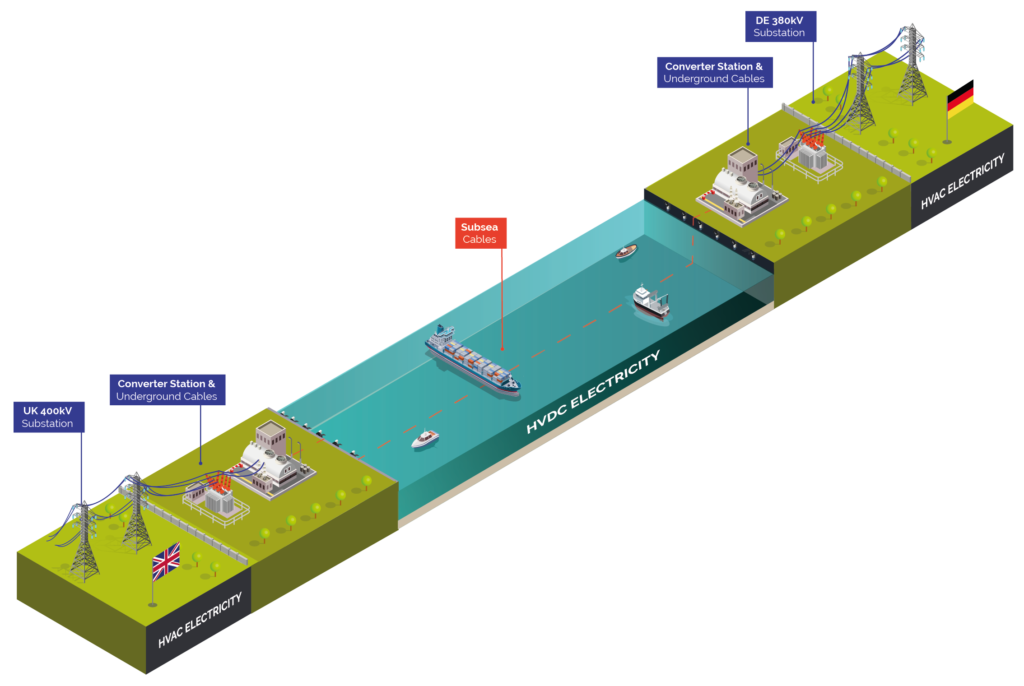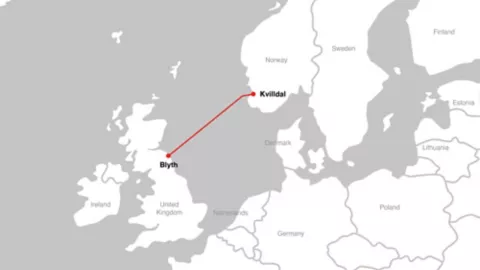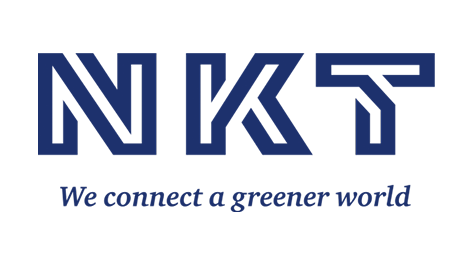NKT – NKT awarded record orders for world’s first 525 kV XLPE HVDC submarine cable projects for offshore wind
 NKT has been awarded three turnkey high-voltage power cable projects for the IJmuiden Ver and Nederwiek Offshore Wind Zones in the Netherlands.
NKT has been awarded three turnkey high-voltage power cable projects for the IJmuiden Ver and Nederwiek Offshore Wind Zones in the Netherlands.
The projects have a combined order value of approx. EUR 2bn (approx. EUR 1.9bn in std. metal prices) making the award a new company record for NKT as the largest combination of orders ever received.
NKT has been awarded three turnkey high-voltage power cable projects for the IJmuiden Ver and Nederwiek Offshore Wind Zones in the Netherlands. The projects have a combined order value of approx. EUR 2bn (approx. EUR 1.9bn in std. metal prices) making the award a new company record for NKT as the largest combination of orders ever received.
The wind zones are located in the Dutch part of North Sea, where the Dutch-German Transmission System Operator (TSO) TenneT is preparing the grid connection for several offshore wind farms. NKT has been awarded the turnkey projects to design, produce, install and commission approx.1,700 km of 525 kV XLPE high-voltage direct current (HVDC) covering both on- and offshore power cable systems for the project lots Beta, Gamma and Nederwiek 2 with total installed capacity of 6 GW.
NKT President and CEO Alexander Kara says: – I am very satisfied with the award which confirms our strong position in the high-voltage power cable market and our long-standing relationship with TenneT. I am excited that our leading turnkey expertise within 525 kV XLPE HVDC technology results in NKT being the first power cable manufacturer to apply this technology to sea cables. We welcome that TenneT increases the focus on sustainability factors by introducing Environmental Cost Indicators in the projects with the aim to reduce the carbon footprint of power cable systems.
In order to decrease carbon emissions, NKT plans to use a partial amount of recycled metal for the conductors and manufacture the cables at the high-voltage factory in Karlskrona, Sweden, which is running on renewable electricity. Furthermore, installation is planned to be done by NKT Victoria, one of the most advanced and fuel-efficient cable laying vessels in the industry.
The six wind farms in the IJmuiden Ver and Nederwiek Offshore Wind Zones have a total capacity of 12 GW. The zones are key in supporting the European transition to renewable energy and play an integral part in realizing the Dutch ambition of having 21 GW offshore wind installed around 2030.
Tim Meyerjürgens, COO TenneT says:
– Recent geopolitical developments have again underlined the need to invest in electricity transmission, to ensure energy security by accelerating the energy transition. By realising the world’s first 525 kV XLPE HVDC offshore cable systems to connect 2 GW projects, we jointly reconfirm our front runner position in offshore grid development and our commitment to deliver on the joint ambition to develop the North Sea into the green power plant of Europe.
Production of the power cables for the three projects are scheduled to start between 2024-27 with expected commissioning in 2028-30. The order award does not change the 2023 financial outlook for NKT.
Source
NKT
EMR Analysis
More information on NKT: See the full profile on EMR Executive Services
More information on Alexander Kara (President and CEO, NKT): See the full profile on EMR Executive Services
More information on TenneT: https://www.tennet.eu/energy-transition + Next time you turn on the lights, take a moment to think about where that power comes from. In the Netherlands and Germany, it was very likely brought to you by us, TenneT. We own and operate over 24,500 kilometres of high-voltage lines and cables.
As the Transmission System Operator (TSO) for the Netherlands, and a significant part of Germany, TenneT owns and operates over 24,500 kilometres of high-voltage lines and cables. We deliver electricity to 42 million domestic and business users, safely and reliably, 24 hours a day and 365 days a year. With over 6,600 employees in two countries, we are driven by our mission to ensure the lights stay on and that power is available, at the flick of a switch, whenever and wherever you need it.
To do this, we design, build, maintain and operate a high-voltage grid stretching across land and sea. This carries electricity from where it is made – including a rapidly increasing proportion of wind and solar energy – to where it is used. We carry it over ground, underground, under the sea and across borders, over our rapidly expanding high-voltage grid. With a service level as high as 99.99%, we are one of the best in the world at our job.
More information on Manon van Beek (CEO, TenneT): https://www.tennet.eu/about-tennet/our-organisation/executive-board + https://www.linkedin.com/in/manonjjvanbeek/
More information on Tim Meyerjürgens (Chief Operations Officer, TenneT): https://www.tennet.eu/company/profile/executive-board/ + https://www.linkedin.com/in/tim-meyerjürgens-611922163/?originalSubdomain=de
EMR Additional Notes:
- HVAC (High Voltage Alternating Current):
- HVAC stands for High Voltage Alternating Current. When the supply voltage of the transmission system is ranging from 33 kV AC to 230 kV AC, it is called high voltage alternating current (HVAC) transmission.
- In the HVAC transmission, the power generated is stepped up to the high voltages and then transmitted by the transmission lines. It requires at least three line conductors for transmitting the three phase electrical power. However, the HVAC voltage transformation and transmission is simple and inexpensive.
- XLPE:
- Cross-linked polyethylene, commonly abbreviated PEX, XPE or XLPE, is a form of polyethylene with cross-links.
- XLPE or Cross-linked polyethylene is a thermoset insulation material. Crosslinking polymers is a process which changes the molecular structure of the polymer chains so that they are more tightly bound together and this crosslinking is done either by chemical means or physical means.
- XLPE is suitable for voltage ranges from low to extra high voltage, surpassing other insulation materials such as PVC, Ethylene Propylene Rubber (EPR) and silicone rubbers. Cross-linking the polyethylene also enhances the chemical and oil resistance at elevated temperatures and makes it suitable for use as a Low Smoke Zero Halogen material.
- Carbon Dioxide (CO2):
- Primary greenhouse gas emitted through human activities. Carbon dioxide enters the atmosphere through burning fossil fuels (coal, natural gas, and oil), solid waste, trees and other biological materials, and also as a result of certain chemical reactions (e.g., manufacture of cement). Carbon dioxide is removed from the atmosphere (or “sequestered”) when it is absorbed by plants as part of the biological carbon cycle.
- Decarbonization:
- Reduction of carbon dioxide emissions through the use of low carbon power sources, achieving a lower output of greenhouse gasses into the atmosphere.
- HVDC Light:
- HVDC Light is the successful and environmentally-friendly way to design a power transmission system for a submarine cable, an underground cable, using over head lines or as a back-to-back transmission. HVDC Light is HVDC technology based on voltage source converters (VSCs).
- HVDC Light is designed to transmit power underground and underwater, also over long distances. It offers numerous environmental benefits, including “invisible” power lines, neutral electromagnetic fields, oil-free cables and compact converter stations.
- As its name implies, HVDC Light is a dc transmission technology. However, it is different from the classic HVDC technology used in a large number of transmission schemes. Classic HVDC technology is mostly used for large point-to-point transmissions, often over vast distances across land or under water. It requires fast communications channels between the two stations, and there must be large rotating units – generators or synchronous condensers – present in the AC networks at both ends of the transmission. HVDC Light consists of only two elements: a converter station and a pair of ground cables. The converters are voltage source converters, VSC’s. The output from the VSC’s is determined by the control system, which does not require any communications links between the different converter stations. Also, they don’t need to rely on the AC network’s ability to keep the voltage and frequency stable. These feature make it possible to connect the converters to the points bests suited for the AC system as a whole.
- HVDC (High-Voltage Direct Current):
- Key enabler for a carbon-neutral energy system. It is highly efficient for transmitting large amounts of electricity over long distances, integration of renewables and interconnecting grids, opening up for new sustainable transmission solutions.
- HVDC Links:
- The first successful HVDC experimental long distance line (37 miles) was made at Munich, Germany in 1882 by Oskar Von Miller and fellow engineers.
- HVDC allows power transmission between AC transmission systems that are not synchronized. Since the power flow through an HVDC link can be controlled independently of the phase angle between source and load, it can stabilize a network against disturbances due to rapid changes in power.
- An HVDC line has considerably lower losses compared to HVAC over longer distances.

- Neu Connect (the first power interconnection between Great Britain and Germany): https://neuconnect-interconnector.com +
- The NeuConnect Interconnector will create the first direct power link between Germany and Great Britain, connecting two of Europe’s largest energy markets for the first time. Around 720km of land and subsea cables will form an ‘invisible highway’ allowing up to 1.4GW of electricity to move in either direction, enough to power up to 1.5 million homes over the life of the project.

- The Tyrrhenian Link: https://www.terna.it/en/projects/public-engagement/Tyrrhenian-link +
- Connecting Sicily with Sardinia and the Italian peninsula via a double underwater cable: a new electricity corridor at the centre of the Mediterranean; the Tyrrhenian Link. At 950 kilometres long and with a capacity of 1000 MW, this is an infrastructure initiative of international significance, another step towards a more sustainable energy future. The link will improve electricity exchange capacity, facilitate the development of renewable energy sources, and the reliability of the grid.
- The overall project involves two sections: EAST from Sicily to Campania and WEST from Sicily to Sardinia.
- The East section is 480 kilometres long and connects the Fiumetorto landing point, in the municipality of Termini Imerese in Sicily, with the landing point in Torre Tuscia Magazzeno, near Battipaglia in Campania.
- The WEST section is approximately 470 kilometres long and connects the Fiumetorto landing point to the one in Terra Mala, in Sardinia.

- The Viking Link: https://viking-link.com +
- World’s longest power interconnection. the Viking Link is a 1400 MW high voltage direct current (DC) electricity link between the British and Danish transmission systems connecting at Bicker Fen substation in Lincolnshire and Revising substation in southern Jutland, Denmark.

- The North Sea Link: https://northsealink.com/ + North Sea Link is a 720 kilometre subsea interconnector linking the electricity systems of the UK and Norway. The 1400 megawatt interconnector stretches from Blyth in the UK, across the North Sea, to Kvilldal in Norway.

- The Hertel–New York interconnection line: https://www.hydroquebec.com/projects/hertel-new-york-interconnection/ + The Hertel–New York interconnection line project aims to supply clean, renewable energy to New York City. In Québec, the project involves the construction of a line that will span 57.7 km (56.1 km underground and 1.6 km underwater). This 400-kV direct current line will connect Hertel substation in La Prairie to an interconnection point in the Rivière Richelieu at the Canada–United States border.

- Low Voltage (LV):
- The International Electrotechnical Commission (IEC) defines supply system low voltage as voltage in the range 50–1000 V AC or 120–1500 V DC.
- Medium Voltage (MV):
- Medium-voltage circuit breakers rated between 1 and 35/72 kV.
- High Voltage (HV):
- The International Electrotechnical Commission define high voltage as above 1000 V for alternating current, and at least 1500 V for direct current.
- Super High-Voltage:
- Is >300kV.
- Ultra High-Voltage:
- Is >1.000kV.
- Grid, Microgrids and DERs:
- The power grid is a network for delivering electricity to consumers. The power grid includes generator stations, transmission lines and towers, and individual consumer distribution lines.
- The grid constantly balances the supply and demand for the energy that powers everything from industry to household appliances.
- Electric grids perform three major functions: power generation, transmission, and distribution.
- A microgrid is a small-scale power grid that can operate independently or collaboratively with other small power grids. The practice of using microgrids is known as distributed, dispersed, decentralized, district or embedded energy production.
- Smart Grid is any electrical grid + IT at all levels . Micro Grid is a group of interconnected loads and DERs (Distributed energy resources) within a clearly defined electrical and geographical boundaries witch acts as a single controllable entity with respect to the main grid.
- Distributed energy resources (DERs) are small-scale electricity supply (typically in the range of 3 kW to 50 MW) or demand resources that are interconnected to the electric grid. They are power generation resources and are usually located close to load centers, and can be used individually or in aggregate to provide value to the grid.
- Common examples of DERs include rooftop solar PV units, natural gas turbines, microturbines, wind turbines, biomass generators, fuel cells, tri-generation units, battery storage, electric vehicles (EV) and EV chargers, and demand response applications.

